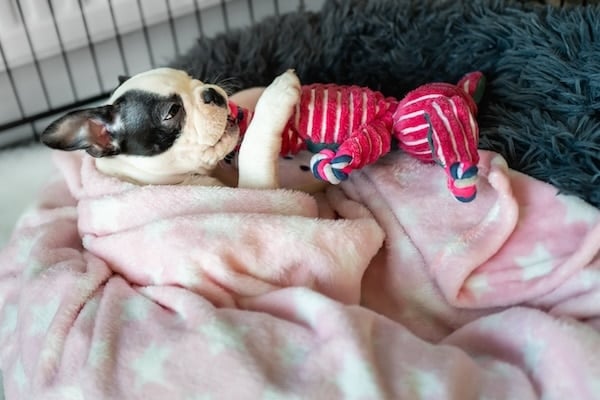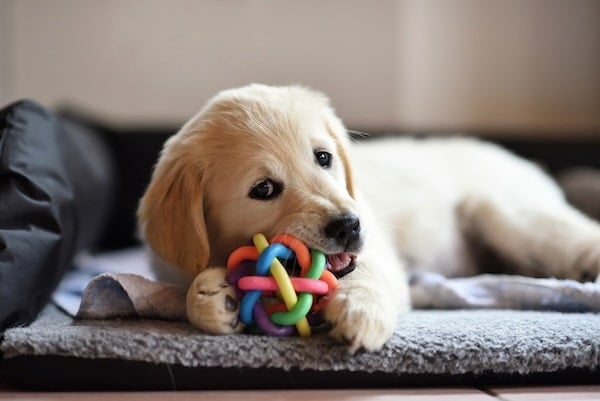- This post contains affiliate links. Read more here.
- Not a substitute for professional veterinary help.
Setting up a crate for your puppy seems simple—just add a bed and a toy, right? Not quite. The right crate setup can make a big difference. Getting everything ready in advance sets your puppy up for success, while not being prepared may make crate training more challenging.
Fear-free certified dog trainer Rachel Lane, founder of Leash and Learn, explains that every puppy is different, and what works for one may not work for another. In this article, we’ll cover what to put in a puppy crate, what to avoid, and how to create a safe, enriching space that meets your puppy’s unique needs.
What To Put In a Puppy’s Crate
Setting up your puppy’s crate with the right items can help them feel secure, comfortable, and ready to learn positive crate habits. Here’s what to include in your puppy’s crate during the day, at night, and during the crate training process.
Essentials
Every puppy needs a few key items in their crate to make it a safer and cozier space.
What to include:
- A properly sized crate (big enough for your puppy to stand up, turn around, and lie down)
- A crate mat, blanket, or bed (if your puppy isn’t a chewer)
- A few safe chew toys (like a puppy-safe rubber toy) to give your puppy mental stimulation and help them settle
- A spill-proof water bowl or dispenser
Whether or not you should include bedding in your puppy’s crate is a common question. According to Lane, some puppies do great with bedding, while others chew it or have accidents on it. For these puppies, Lane advises to remove the bedding, start with a bare crate floor, and introduce a mat later.
What to put in a puppy’s crate while you’re at work
If your puppy will be crated while you’re out for the day at work, they might need specific items to keep them occupied.
What to include:
- A long-lasting chew (like a frozen, food-stuffed toy) or an interactive toy
- A safe, puppy-proof water bowl
- A snuggle or heartbeat toy
Young puppies shouldn’t be crated for long hours without potty and playtime breaks. If you’ll be gone for more than a few hours, consider a playpen setup with puppy pads or arrange for someone to let them out. The goal is to keep the crate a positive place, not a space where they feel trapped or frustrated.
-
CBCK-Christine via iStock
What to put in a puppy’s crate during training
When you’re actively crate training your puppy, what you include in their crate can help them build positive associations with it.
What to include:
- Training treats for rewarding calm behavior
- A crate cover (if your puppy finds it soothing)
During training, it’s especially important that the crate should feel like a welcoming space, not a punishment. Some puppies enjoy a partially covered crate because it makes the space feel like a cozy den.
“Dogs should be supervised with a crate cover before being left alone with the cover on, to ensure they don’t pose any type of hazard,” recommends Lane.
What to put in a puppy’s crate at night
The first night with your puppy is usually the toughest, as they’re likely adjusting to sleeping without their mother or littermates. If you choose to crate your puppy at night, you’ll want to make their space as calm and comfortable as possible to minimize middle-of-the-night disruptions.
What to include:
- A white noise machine or soft music
- A t-shirt or other clothing item with your scent or their mother’s scent
- Calming pheromone spray
White noise or soothing music can help calm your puppy and cover up any distracting nighttime sounds. Dog calming pheromone sprays have also been proven effective at easing separation anxiety.
What Not To Put In a Puppy’s Crate (Right Away)
Some things are obvious no-gos for a puppy’s crate, like anything sharp, toxic, or small enough to swallow. But other items, even ones that seem safe, may need testing or supervision before leaving your puppy alone with them. Puppies are naturally curious (and sometimes destructive), so it’s important to be cautious and troubleshoot items that could be risky.
Choking hazards
What to avoid:
- Collars, leashes, and harnesses
- Toys with plush stuffing or squeakers
- Rope toys or anything with loose threads
- Small chew toys that could be swallowed
- Treats or chews that break into chunks
Lane emphasizes that collars should always come off before your puppy goes in their crate. “All dogs, regardless of age or size, should never be in a crate wearing any sort of equipment,” she cautions.
Puppies explore the world with their mouths, and some will tear apart plush toys or ropes in minutes. Stuffing, squeakers, and small pieces can be swallowed and are a choking hazard. Even edible chews can be risky if they break into hard, sharp pieces.
“I recommend avoiding antlers because they can break teeth, and being cautious with bully sticks,” adds Lane. “Some puppies will get an upset stomach from them, and others may swallow them without chewing them properly.”
Dangerous materials
What to avoid:
- Plastic or fabric bedding if your puppy chews
- Electrical heating pads
Many puppies chew on their bedding, which can lead to them swallowing fabric or foam. Instead of plush bedding, start with a durable mat and introduce softer materials once you’re confident your puppy won’t shred them. Additionally, heating pads can overheat or have wires that curious puppies may try to chew.
Unstable items
What to avoid:
- Stackable or hanging water dispensers
- Food bowls that slide around
- Loose crate dividers that could collapse
If an item can tip, slide, or fall over, it’s best to leave it out. Some puppies paw at their bowls or push on crate dividers, which can cause them to fall or trap a paw. Look for secure, crate-mounted water dispensers and properly fitted dividers to avoid any mishaps.
Crate placement and proximity to dangers
What to check:
- Keep the crate away from electrical cords, drapes, or blinds as part of puppy-proofing
- Make sure the crate isn’t near anything your puppy can reach through the bars
- Avoid putting the crate in direct sunlight
- Keep the crate out of busy areas of the house where loud noises may startle your puppy during nap time
Even if the inside of the crate is safe, what’s around it can be hazardous. Puppies can sometimes reach wires, curtains, or anything else through the crate bars with their paws or mouths.
-
Photology1971 via iStock
What To Do If Your Puppy Chews
Chewing is a natural phase for puppies, but when your puppy starts destroying everything in their crate, it can be frustrating and even dangerous. Instead of fighting against their need to chew, focus on giving them safe, appropriate options.
If your puppy consistently shreds bedding or toys, consider limiting what’s in the crate until you find more durable solutions, and supervise crate time when introducing new toys to see what holds up best.
So what are some crate-safe chew options for puppies? Lane recommends experimenting with no-hide chews and non-toxic plastic bones.
Here are some other popular chew toy options for the crate:
- KONG Rubber Toy. Sturdy options like KONGs can be stuffed with treats or frozen for extra enrichment.
- Nylabone Freezer Puppy Chew Toy. This toy provides cooling relief for puppies going through teething stages.
- Benebone Puppy Dog Chew Toy. For more determined chewers, these toys offer a satisfying, softer texture.
- Petstages Cutie Chewies Dog Toy. Made from flexible rubber, it’s gentle on puppy teeth but still holds up to chewing.
Always supervise new chew items before leaving them in the crate with your puppy to make sure they don’t break off large pieces and swallow them.
Could chewing be a sign of a bigger issue?
If your puppy is excessively destructive, it may be a sign of boredom, frustration, or even anxiety. Puppies who aren’t getting enough physical exercise or mental stimulation may chew out of restlessness. Try adding more structured playtime, training sessions, or puzzle toys outside the crate to help them burn off energy.
Separation anxiety in a puppy can also lead to frantic chewing or escape attempts. If your puppy shows signs of stress when crated alone, consider working with a positive reinforcement trainer to help your puppy learn that the crate is a safe space.
Benefits of Making the Crate a Fun Space
When you take the time to set up your puppy’s crate thoughtfully and make it a positive place, you’re giving them a valuable life skill. A puppy who enjoys their crate will rest more easily, feel more secure, and travel well.
“There are so many benefits of having a dog who likes their crate,” says Lane. “Potty training is easier, they can safely travel in the car in a crate, and they are more happy going into a crate at the vet. It’s a great life skill for every dog to have.”







